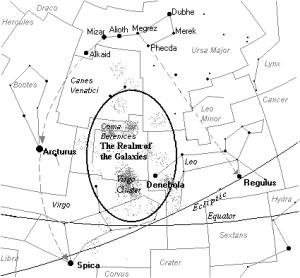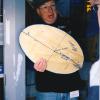The Realm of the Galaxies
Look north any clear spring evening and you'll find the Big Dipper. Using the ditty "follow the arc to Arcturus and speed onto Spica" trace out a great arc to the south through Arcturus and Spica. Return to the Dipper to use Megrez and Phecda (in the bowl) as pointers to Regulus the brightest star in Leo [the Lion]. Between these traces and above the line between Spica and Regulus lies the Realm of the Galaxies. The only really bright star in this area is Denebola, the tip of the lion's tail. The title of Realm of the Galaxies only appears in a few texts, but it is fully justified.The Realm contains thousands of galaxies. Nowhere else in the sky is the concentration even remotely as high. On the boundary between Virgo [the Girl] and Coma Benenices [Bernice's Hair] is the enormous Virgo Cluster. The Virgo Cluster is 60 million [give or take 10 million] light-years away. The Local Group (including our Milky Way) has fewer than forty galaxies. The Virgo Cluster has more than a thousand. These thousand galaxies are crowded in a volume just slightly larger than the volume of the Local Group (a radius of about 3-4 light-years). Skies in the Virgo Cluster must have hundreds of galaxies easily visible to the unaided eye. A typical Virgo galaxy is the size of our own Milky Way. Since the Milky Way contains about two billion stars, the Virgo Cluster must hold trillions of stars.Until this Spring, Virgo, Coma and Leo have been frustrating constellations for me. I've seen wonderful pictures from these constellations in astronomy texts, star maps and atlases for decades. However my small telescope, excellent as it optics are, simply does not have the aperture required to collect enough light to see these galaxies as anything more than points of light. These faint dots are indistinguishable from stars. All this changed when we installed the 16" telescope at our Observatory. Suddenly these faint dots became clear shapes with identifiable features and sufficient brightness to allow me to really see them.In March, well after midnight, I got my first clear view of one of the most famous of the galaxies in the Realm of the Galaxies - M104 the Sombrero Galaxy (east of Spica). And indeed, M104 does look like a Sombrero sitting on a mirror. Between the crown of the hat and the mirrored reflection is a dark band. We know that this area without stars is in fact a band of dust which rims this galaxy. Even in the eyepiece of the 16", many of the galaxies in this area overlap each other! There simply isn't room enough in this region of the sky to fit them. Some of the galaxies look like familiar objects - for example one combination [NGC4435 & NGC4438] are called the Eyes because they look like eyes staring back at us!Galaxies come in three basic shapes, spiral, irregular and elliptical. The shape tells us much about the galaxies history. We think that most galaxies start as spirals. Our Milky Way and M51 the Whirlpool are typical examples. Spirals look like the spinning fireworks we call St. Catherine's Wheels. When a small spiral wanders too close to a large spiral it comes away much the worse for wear. Our two satellite galaxies, the Large and Small Magellenic Clouds, are examples. In the past, they were much closer. The huge gravity of Milky Way stripped them of many stars and distorted their shapes changing them into irregular galaxies. The Milky Way isn't through with its piratical behavior. It is currently dismembering the Sagittarius Galaxy.When large galaxies encounter a plentiful supply of smaller galaxies they grow to prodigious sizes. Their disk shape distends rather like a flat balloon as air is pumped in. In this way the final class of galaxies is formed, the ellipticals. While small ellipticals exist, many ellipticals are giants. Almost spherical in shape and bearing only traces of their former spiral shape the ellipticals are the behemoths of the sky. Small wonder that many huge ellipticals were formed in the Virgo Cluster where so many galaxies are crowded together.We hope you'll join us at the Observatory while the planets are hidden (The planets are either playing hide and seek with the Sun or they rise long after bedtime). We won't be able to show you all those multiple thousand galaxies in a night but recently we managed to show more than four dozen different galaxies to three dozen visitors in a single evening.
- Author:
- Leslie Coleman
- Entry Date:
- Apr 1, 2000
- Published Under:
- Leslie Coleman's Columns


